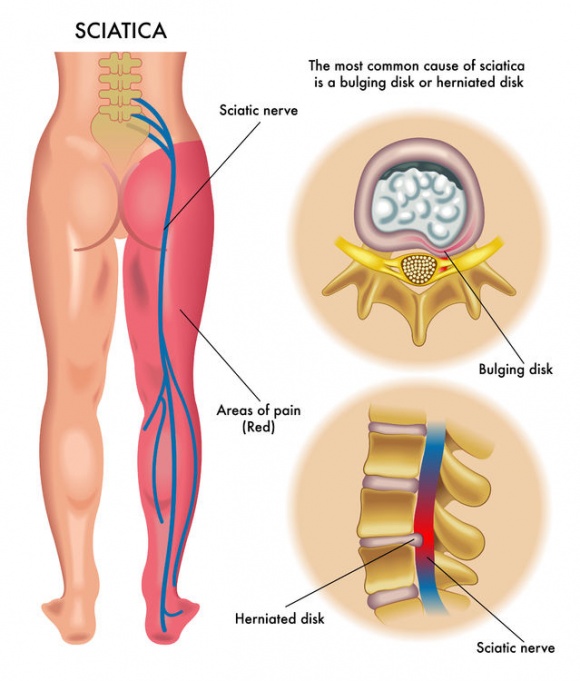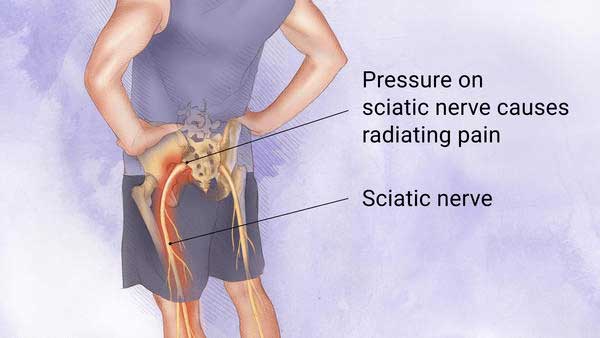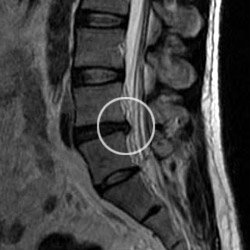Sciatica is one of those conditions that many people have heard of, but few truly understand until it happens to them. It’s more than just a sore back. It can cause sharp, shooting pain that radiates down one leg, sometimes making it difficult to sit, stand, or even sleep comfortably.
For some, the pain comes and goes; for others, it can linger for weeks or even months, affecting their ability to work, drive, or enjoy everyday life. Sciatica can take a real physical and emotional toll, especially when relief feels out of reach.
What Is Sciatica?
Sciatica refers to pain caused by irritation or compression of the sciatic nerve, the body’s longest nerve, which runs from the lower back down through the hips and legs. When this nerve is pinched or inflamed, the pain can travel anywhere along its pathway.

Figure 1: The sciatic nerve runs from the lower spine down the leg. A bulging or herniated disc can compress the nerve and cause pain.
Common causes include:
- Herniated or slipped discs that press on a nearby nerve
- Spinal stenosis (narrowing of the spinal canal)
- Piriformis syndrome (a tight muscle irritating the nerve)
- Injuries, repetitive strain, or prolonged poor posture
How Common Is Sciatica?
Sciatica is surprisingly common. Studies show that up to 40% of people experience it at some point in their lives. Around 5–10% of all lower back pain cases involve true sciatica, and about 2% of the population develop disc-related sciatica each year. For some, symptoms resolve quickly; for others, pain may persist for months or even years if not properly treated.
Symptoms of Sciatica
The symptoms of sciatica can vary, but they often include:
- Pain that radiates from the lower back or buttock down the leg
- Numbness, tingling, or a “pins and needles” sensation
- Muscle weakness in the leg or foot
- A burning or electric shock-like feeling
For many people, even simple tasks like walking, bending, or sitting can become uncomfortable. If symptoms appear suddenly or are accompanied by severe leg weakness or bladder/bowel changes, seek immediate medical attention.
Traditional Treatments for Sciatica
Traditional medical treatments typically focus on managing pain rather than addressing the underlying cause. These might include pain relief medication, anti-inflammatories, physiotherapy, stretching exercises, or cortisone injections. In more severe cases, surgery (such as a microdiscectomy) may be considered.
While these treatments can help in the short term, they may not always prevent future flare-ups. Medication can also cause side effects or lose effectiveness over time, which is why many people explore natural, non-invasive options like chiropractic care.
How Chiropractic Care Can Help With Sciatica
Chiropractic care focuses on improving spinal alignment and joint movement, which in turn supports healthy nerve function. If your sciatica is caused by pressure on a nerve root or spinal misalignment, chiropractic adjustments may help reduce that pressure, easing inflammation and pain.
Common Chiropractic Techniques for Sciatica
- Spinal adjustments to restore proper motion and relieve nerve compression
- Soft tissue therapy to relax tight muscles like the piriformis
- Gentle mobilisation to improve flexibility and circulation
- Rehabilitation exercises and posture advice to support recovery

Figure 2: Chiropractic care can relieve pressure on the sciatic nerve by improving spinal alignment and mobility.
Research supports this approach. In one clinical trial, 55% of patients receiving chiropractic adjustments became pain-free compared to only 20% of those given simulated (placebo) adjustments. Other studies show chiropractic patients report reduced pain, improved mobility, and lower reliance on painkillers, especially opioids, over time.
Benefits of Chiropractic Care for Sciatica
- Natural, drug-free pain relief
- Improved mobility and flexibility
- Reduced inflammation around the sciatic nerve
- Support for posture and movement to prevent flare-ups
- Personalised care tailored to your symptoms
Rather than waiting for the pain to fade, chiropractic care promotes active recovery, helping your body heal through movement and improved function.
What to Expect During a Chiropractic Visit
During your first visit, your chiropractor will discuss your symptoms and perform a thorough exam, assessing your posture, spinal movement, and nerve response. If needed, imaging such as X-rays or an MRI may be recommended to identify the cause of your sciatica.

Figure 3: MRI scan showing a disc herniation in the lower spine, one of the most common causes of sciatica.
Your chiropractor will then outline a personalised care plan that may include spinal adjustments, soft tissue therapy, exercises, and follow-up visits. The care provided should always be gentle, targeted, and safe.
When to Consider Chiropractic Care for Sciatica
If your sciatica hasn’t improved with rest, stretching, or over-the-counter treatments, chiropractic care may be worth considering. It’s particularly effective for recurring or chronic cases where nerve irritation is linked to spinal or muscular issues.
However, if you experience sudden leg weakness, loss of bladder or bowel control, or suspect an underlying condition such as infection or tumour, seek immediate medical attention. A professional chiropractor will always refer you to the appropriate specialist when necessary.
To help explain how chiropractic care can assist with sciatica, Dr. David Black shares a real patient case and his treatment approach in the podcast below.
Chiropractors Who Treat Sciatica
If you’re struggling with sciatic nerve pain, Drs. Michael and David Black bring over 40 years of experience helping people just like you. They combine traditional and modern chiropractic techniques to deliver safe, effective relief from sciatica and related back pain.
As BUPA Members First Providers, we offer savings for eligible clients and process private health fund claims electronically. We also accept Medicare EPC referrals, and after-hours care is available by appointment.
To take the first step toward lasting relief, call 0483 960 996 to book your consultation today. Whether your goal is to get back to work, enjoy a good night’s sleep, or move without pain, our team is here to help you get there.
Resources
- Ropper AH, Zafonte RD. Sciatica. New England Journal of Medicine. 2015;372(13):1240–1248.
- Konstantinou K, Dunn KM. Sciatica: Review of epidemiology, pathophysiology, and clinical management. British Journal of General Practice. 2008;58(554):449–453.
- National Institute for Health and Care Excellence (NICE). Low Back Pain and Sciatica in Over 16s: Assessment and Management. NG59, updated 2020.
- Santilli V, Beghi E, Finucci S. Chiropractic manipulation in the treatment of acute back pain and sciatica with disc protrusion: a randomized double-blind clinical trial. Spine. 2006;31(13):E480–E486.
- Goertz CM, et al. Patient-Reported Outcomes of Chiropractic Management of Low Back Pain and Sciatica. JMPT. 2018;41(7):518–527.
- Kazis LE, et al. Association Between Chiropractic Care and Use of Prescription Opioids Among Adults With Sciatica or Low Back Pain. Pain Medicine. 2020;21(2):e79–e86.
- O’Connell NE, et al. Non-surgical treatment (excluding epidural injections) for lumbar radiculopathy. Cochrane Database Syst Rev. 2021;2021(12):CD013577.
- Chou R, et al. Diagnosis and Treatment of Low Back Pain: A Joint Clinical Practice Guideline. Ann Intern Med. 2007;147(7):478–491.
Frequently Asked Questions
How long does it take for chiropractic care to help sciatica?
Every case is different, but many patients notice improvement after the first few sessions. For acute cases, significant relief often occurs within two to six weeks of consistent care. Chronic sciatica may require a longer, more gradual approach focusing on posture and strength.
Is chiropractic care safe for sciatica?
When performed by a qualified professional, chiropractic adjustments are generally very safe. Most patients experience mild soreness at first, similar to post-exercise stiffness, which usually resolves quickly. Your chiropractor will tailor your treatment to your comfort level and health needs.
Can chiropractic care prevent future sciatica flare-ups?
Yes. By addressing poor spinal movement, posture, and muscle imbalance, chiropractic care can help prevent future episodes. Many patients benefit from periodic “maintenance” visits and at-home stretches to keep the spine and surrounding muscles in balance.

